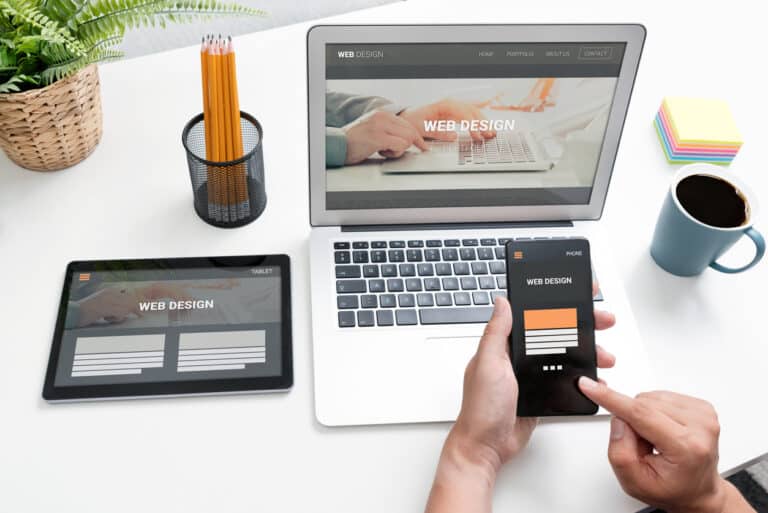Are you trying to understand adaptive design and when it’s best used? You’re in the right place!
Adaptive design can be a powerful tool for creating websites that look great on any device or screen size, but it’s important to know when adaptive design is the right choice.
In this blog post, we’ll dive into adaptive design basics, compare adaptive and responsive designs, and provide tips on which one will work best for your project. So read on – let’s get started!
What is adaptive design?
Adaptive web design is a website design approach that ensures the site’s layout adapts to different screen sizes, providing an optimal viewing experience for visitors.
It works by using design elements and coding techniques tailored to the device being used by the visitor, ensuring that content and features are displayed in a way that is most suitable for their particular device. As a result, adaptive designs offer unique advantages (and disadvantages) compared to traditional responsive web design.
Let’s explore adaptive design vs responsive design in more depth.
Adaptive design vs. responsive design
Both adaptive and responsive designs serve the same purpose – optimizing a website to look great on any device including mobile devices. However, adaptive design takes a slightly different approach than responsive design.
Responsive sites use “fluid” layouts that resize and rearrange elements depending on the size of the screen being used, while adaptive design uses predefined “breakpoints” to determine how the layout should change.
This difference is best illustrated with an example. Take this website layout from Booking.com that looks like this on a desktop computer:

On a smartphone, a responsive design would simply resize the columns into one column, stacking them on top of each other.
But adaptive sites would use pre-defined breakpoints to determine the best layout for small screens, rearranging the columns in a different way. See the mobile version of the same page on Booking.com:

The mobile version uses a quite different design layout where even some content is completely removed so that the mobile UX is more streamlined. As you can see, adaptive design offers more control when it comes to visual hierarchy on different devices – but it also requires more time and effort due to its reliance on predefined breakpoints.
Pros and cons of adaptive design
Adaptive design offers many advantages, including:
- More control over how webpages look on different devices.
- Ability to create custom layouts for each screen size and device type (desktop, tablet, mobile device).
- Reduced bandwidth usage as adaptive design only loads content that is necessary for the current viewport size.
- Adaptive design is great for larger websites like Amazon that need to optimize faster page load speeds and a consistent UX, regardless of the device they were accessing the site from.
However, adaptive design also has some drawbacks:
- More time and effort required to create adaptive websites, as each breakpoint needs to be designed separately.
- Unpredictable behavior in browsers with non-standard viewport sizes (such as those on smart TVs), due to lack of pre-defined breakpoints.
- Difficulty testing adaptive layouts, as each device size needs to be tested separately.
- Website builders like Wix and WordPress plugins like Elementor make responsive design really easy nowadays. Adaptive design, on the other hand, might take a lot more custom designing, so it could be disadvantageous as far as time efficiency goes.
So, as you can see, adaptive design is a great option for larger websites that need to provide an optimized user experience across multiple devices – but it may not be the right choice for smaller websites. Let’s take a look at how you can decide if an adaptive or responsive design is right for you.
6 Tips on deciding whether to use responsive or adaptive design
As we’ve seen above, responsive and adaptive design each have their own advantages and disadvantages, so it can be hard to decide which one is right for you.
Here are some tips on deciding whether an adaptive site or a responsive site is more suitable for your project:
1. Consider site speed
Adaptive sites require more code and hence can be slower to load. If page speed is a priority for your website, then adaptive design may not be the right choice. This is because adaptive design has to load multiple versions of the same element, depending on the device size.
2. Think about UX
UX refers to how user-friendly your website is. Adaptive design is great for larger websites that need to provide a consistent and optimized user experience across all devices. On the other hand, responsive sites are much more suited for smaller websites where speed is more important than a tailored user experience.
3. Evaluate your content
When choosing between adaptive websites and responsive websites, you have to consider the content on your site. Adaptive design is best for websites with a lot of content (such as image galleries, videos, infographics, etc.), as adaptive design allows you to customize the layout for each device size.
4. Evaluate budget and timeline
Adaptive design can take more time to design, as it requires the creation of multiple versions for each breakpoint. It can also be more costly due to the extra work involved in developing adaptive sites. If you have limited resources and need to get something up and running quickly, adaptive design can be time-consuming, so responsive design might be the better option.
5. Determine how much control you want
For more control over your website’s design, adaptive design might be the right choice. This is because adaptive design offers more detailed control over how webpages look on different devices.
6. Consider your website builder
Adaptive design is often used because the website builder or WordPress plugin a designer is using lacks certain responsive design capabilities. If a website builder (Avada, for example) can’t support a certain aspect of responsive design or can’t easily make a certain element responsive because of its complexity, then a designer may have to turn to adaptive design by default.
Ultimately, it comes down to what you need from your website and the resources you have available. Be sure to think carefully about these factors before making a decision on which type of design is right for you.

How to implement adaptive design on your website
Once you’ve decided to go with adaptive design, there are several things you need to do in order to implement it successfully:
Create a set of predefined breakpoints for different devices.
This will help ensure that your adaptive website looks good on almost every device size and type. This is super important, as adaptive design will only look good when it has been setup properly.
Test adaptive layouts on each device type.
It’s essential to test your adaptive design on each device type and viewport size in order to ensure that the website looks great for all users no matter the screen sizes. This is especially important if you have complex elements or lots of content – but it’s a good idea to test adaptive sites on any device regardless.
Optimize the loading speed of adaptive websites.
Since adaptive websites are often larger than responsive ones, it’s important to be sure that they are optimized for fast loading times. Look into caching plugins and other ways to optimize your site for faster loading speeds if necessary.
Design each viewport separately.
A viewport is a region of the adaptive website where all the content is visible. When designing adaptive websites, it’s important to design each viewport separately in order to ensure that the user experience is optimized for every device.
Adaptive design requires you to create a unique design for each of your pre-defined breakpoints, so it can take quite a bit of time.
By adhering to these tips, you’ll be able to create an adaptive website that looks great on practically any device and provides a consistent user experience across all platforms.
Best practices when using adaptive design
Even though adaptive design can be a powerful tool for creating unique and effective user experiences, it’s important to keep certain best practices in mind when using it:
Use adaptive design as an enhancement, not a replacement.
Remember that adaptive design should supplement rather than replace your existing responsive website. Use adaptive design to improve the user experience on certain devices, not to completely overhaul an existing design.
Be mindful of device capabilities.
Adaptive design should take into account the different capabilities and limitations of each device when designing for adaptive websites. Mobile phones, for example, may not have as much screen real estate as desktops, so adaptive design should be used to make sure the user experience is optimized for each device.
Test thoroughly for bugs.
Testing adaptive designs across multiple devices is essential in ensuring that all adaptive elements are functioning properly. You can use testing tools like BrowserStack to check adaptive designs on a variety of devices.
By following these best practices when using adaptive design, you can ensure that your adaptive website is providing the best user experience possible.
Common mistakes to avoid with adaptive design
Adaptive design can be a great way to provide an optimized user experience across multiple devices, but there are a few common mistakes that you should avoid when using adaptive design:
Using adaptive design as a replacement for responsive design.
As mentioned previously, adaptive design should be used as an enhancement rather than a replacement for your existing responsive design.
Failing to test adaptive designs across multiple devices.
Testing adaptive designs is essential in ensuring that all adaptive elements are functioning properly, so don’t forget to test your adaptive website on a range of devices.
Not accounting for device capabilities and limitations.
It’s important to take into account the different capabilities and limitations of each device when designing adaptive websites. Consider how adaptive web design is going to operate on a mobile device versus a desktop.
Final thoughts
In conclusion, adaptive design can be great for larger websites that need to provide an optimized experience across multiple devices – but it may not be the right choice for smaller sites.
It’s important to understand the pros and cons of adaptive and responsive design before making a decision on which one is more suitable for your project. With these tips in mind, you should be well on your way to creating adaptive websites that provide the best user experience possible.
Happy designing!
Frequently Asked Questions
What are the principles of adaptive design?
The principles of adaptive design include designing for an optimal user experience across multiple devices, accounting for device capabilities and limitations, and testing thoroughly for bugs.
What is an adaptive design study?
An adaptive design study is a research process that focuses on user behavior and needs across multiple devices. It helps designers understand how users interact with adaptive websites, so they can create an optimal experience.
What is another name for adaptive web design?
Adaptive web design is also known as adaptive design or adaptive layout.
What is an adaptable website?
An adaptive website is one that has been designed to function optimally across multiple devices by adjusting the layout and content according to the device’s capabilities. It can also be referred to as adaptive design or adaptive layout.




